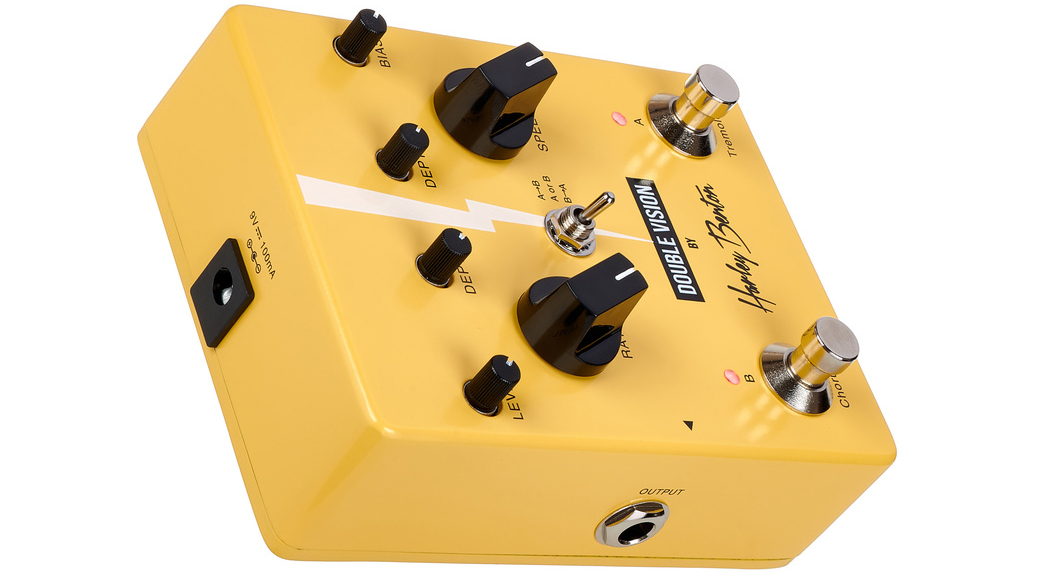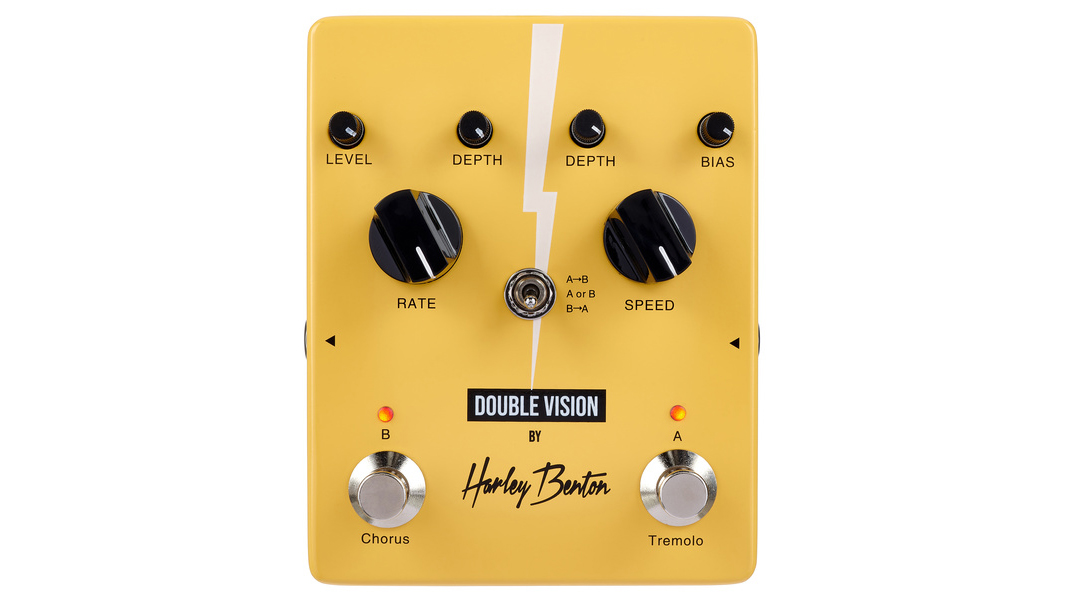MusicRadar Verdict
What the Double Vision lacks in more detailed modes, settings and nuance, it makes up for with solid, reliable sounds.
Pros
- +
Space saving
- +
Solid effect sounds
- +
Affordable
Cons
- -
Possibly not detailed enough at either effect for heavy modulation fans
MusicRadar's got your back
Harley Benton Double Vision Chorus and Tremolo: What is it?
With the pedal market currently experiencing an unprecedented boom, phrases such as ‘pedalboard real estate’ are being used more and more often. Square-inches on our boards are valuable because there’s only a finite amount before we have to get a bigger board, and with so many new stompbox options available on the daily, a phenomenon we’re going to call ‘’board anxiety’ can creep in. You’re eyeing that gap on your pedalboard with intensity thinking ‘Something needs to go there, but if I fill it, I won’t be able to fit any more pedals.’
It’s a blinking competition, and Harley Benton wants you to flinch. These space-saving designs put two pedal circuits into one carcass, meaning that you can cover off a couple of effects with one unit. The Double Vision is home to Tremolo and Chorus, which, depending on the style of music you play could either be extremely important or sounds that you call upon for one-in-every three or four songs.
“Yeah, but I don’t want a compromised either/or solution. I want both!”. Fussy often goes without, but here, the new king of cut-price gear is dusting your cake with a sprinkle of both and allowing you to chomp it down too. That’s because the Double Vision can be one effect, two effects or both.
The Double Vision is split into two sides: A and B. A is Tremolo, B is Chorus, and both sides feature a three-control layout. That’s Speed/Depth/Bias for the trem and Rate/Level/Depth for the chorus.
They’re switched independently, so you can have Tremolo, Chorus or Tremolo and Chorus. “What if I want Chorus then Tremolo?”. That’s also fine, because the small toggle in the middle has three positions. The first runs the signal chain as A into B, position two gives you A or B, and the third mode reverses the effect order for B into A. Aside from those options, it’s a very utilitarian pedal, with an input, output, two bypass switches (true bypass) and mains-only powering.

Harley Benton Double Vision Chorus and Tremolo: Performance and verdict
Harley Benton’s Double Pedal series features nine pedals, each sharing the same enclosure, essentially taking up a similar amount of space as two mini-sized pedals placed side-by-side.
First up is the Tremolo. Harley Benton says it’s a “warm, optical tremolo” and we think that’s fair. If you’re looking for gated, chopping pulses then this probably isn’t the tremolo for you. Instead, it’s a more gentle, subtle effect. With the depth set low we get a smooth wavering to our volume, and cranked up to the maximum setting it’s still got that slower, rounded-edge transition and turning the bias from left to right tightens up the pulses somewhat. It works well on clean and crunchy open chords and surfy single notes, but we found the effect did get lost on more heavily distorted parts.
Want all the hottest music and gear news, reviews, deals, features and more, direct to your inbox? Sign up here.
Fans of watery, 80s/90s alternative rock chorus will love it.
The Chorus side of the pedal is perhaps the one that’s likely to see more action. We started with a fairly slow Rate and medium depth settings. The level control brings in the overall blend of the wet signal, and at these settings, with the level control at halfway, it adds a very useable shimmer to our clean tones.
Most chorus pedals have a spot on the depth control where things go a bit ‘hall of mirrors’. The pitch sweeps just that little bit too far and you start reaching for the anti-nausea pills. But we’re glad that the Double Vision doesn’t get that far. It remains a usable sound even at the highest depth settings, just, and fans of watery, 80s/90s alternative rock chorus will love it.
Combining them is where the fun begins though, most notably in position three, placing the chorus before the tremolo in the chain. Here, the Double Vision does its best attempt at aping a Leslie speaker, especially if you experiment between the rate settings of each effect. There’s plenty of attack left, meaning that you can conjure up some cool funk and fusion-y sounds, ape an organ line on a blues shuffle or delve into Black Hole Sun territory with some higher register arpeggios.
We’re not entirely sure about the Double Vision’s middle-position mode. This allows you to select either one of the effects, but not both at once, which could be useful if you’re prone to misstepping the bypass switches, but beyond that, we think most people will choose their order and treat this like two pedals.
Earlier we mentioned that modulation is either a pedalboard essential, or a ‘nice-to-have’, and we’d say that the Double Vision is ideal if you fall into the latter category. You only need one cable to power it, and it’s straightforward enough to use easily on a crowded ’board. At £70 (or £35 a side), we think that’s a pretty fair deal.
MusicRadar verdict: What the Double Vision lacks in more detailed modes, settings and nuance, it makes up for with solid, reliable sounds.
Harley Benton Double Vision Chorus and Tremolo: Hands-on demos
Harley Benton
EytschPi42
The Bedroom Rocker
Harley Benton Double Vision Chorus and Tremolo: Specifications

- Type: Dual-function Tremolo/Chorus pedal
- Controls: (Chorus) Rate, Level, Depth (Tremolo) Speed, Depth, Bias, three-way signal order switch
- Connectivity: Input, output, power
- Power: 9V PSU only (not included)
- Contact: Thomann

Stuart has been working for guitar publications since 2008, beginning his career as Reviews Editor for Total Guitar before becoming Editor for six years. During this time, he and the team brought the magazine into the modern age with digital editions, a Youtube channel and the Apple chart-bothering Total Guitar Podcast. Stuart has also served as a freelance writer for Guitar World, Guitarist and MusicRadar reviewing hundreds of products spanning everything from acoustic guitars to valve amps, modelers and plugins. When not spouting his opinions on the best new gear, Stuart has been reminded on many occasions that the 'never meet your heroes' rule is entirely wrong, clocking-up interviews with the likes of Eddie Van Halen, Foo Fighters, Green Day and many, many more.
